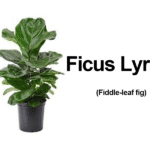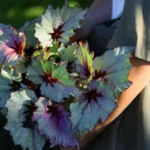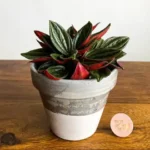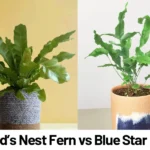Syngonium White Butterfly vs Neon Robusta: A Clear Comparison for Indoor Plant Lovers
For indoor plant lovers and beginner gardeners alike, selecting the right houseplant can be tricky — especially when two specimens look deceptively similar. Syngonium ‘White Butterfly’ and Syngonium ‘Neon Robusta’ are two such plants. They often appear side by side at nurseries and plant shops, share the same genus, and boast similar arrow-shaped leaves and compact growth. But despite their family connection and popularity in the houseplant world, these two cultivars differ in important ways that could influence your buying decision.
Both cultivars belong to the Syngonium podophyllum species and are cherished for their attractive foliage, air-purifying qualities, and relatively low-maintenance nature. However, their foliage color, growth behavior, and adaptability to environments set them apart. In this article, we’ll break down their differences in a side-by-side comparison and help you decide which plant best suits your lifestyle, lighting, and décor goals.
Side-by-Side Comparison Table
| Feature | Syngonium White Butterfly | Syngonium Neon Robusta |
|---|---|---|
| Botanical Name & Family | Syngonium podophyllum ‘White Butterfly’ (Araceae) | Syngonium podophyllum ‘Neon Robusta’ (Araceae) |
| Native Region | Tropical Central and South America | Tropical Central and South America |
| Leaf Shape and Size | Arrowhead-shaped, 5–7 inches long, green with creamy-white center | Arrowhead-shaped, 4–6 inches long, uniformly pink to rose blush |
| Growth Habit & Speed | Fast-growing, bushy then trailing or climbing | Moderate-growing, compact then vining |
| Stem Structure / Identifiers | Green stems with slightly crinkled appearance near nodes | Rosy pink stems, smoother and more delicate-looking |
| Light Requirements (lux) | Prefers bright, indirect light (2,500–10,000 lux); tolerates lower light (1,000–2,500 lux) | Best in bright, indirect light (3,000–10,000 lux); loses color below 2,500 lux |
| Watering & Humidity | Water when top 2 inches dry; thrives in 50–70% humidity | Water when top 1–2 inches dry; prefers 60–80% humidity |
| Pet Safety / Toxicity | Toxic to pets (contains calcium oxalate crystals) | Toxic to pets (contains calcium oxalate crystals) |
| Typical Price / Availability | Widely available; generally <$10 USD for 4″ pot | Moderately available; $10–$15 USD for 4″ pot |
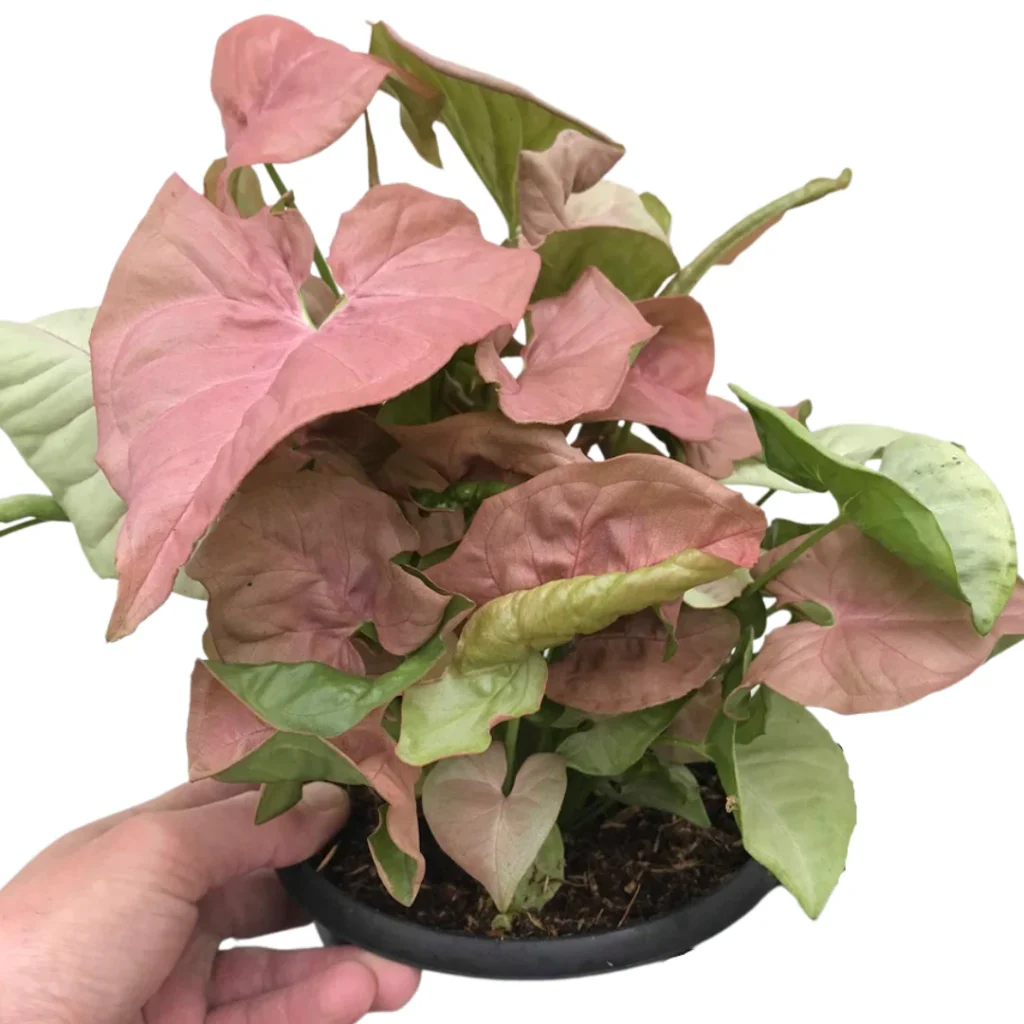
Key Differences Explained
Visual Identity: Dramatic Foliage Contrast
The most striking difference between these two Syngoniums is their foliage color. Syngonium White Butterfly features green arrowhead leaves with creamy or silvery-white variegation concentrated in the center, giving the effect of butterfly wings — hence the name. In contrast, Neon Robusta grabs attention with solid pink to rose-colored leaves. The vibrance of Neon Robusta’s coloration makes it more of a “statement” plant, ideal for those looking to introduce bold color indoors. However, it’s important to note that Neon Robusta’s intense pink hue can fade in low-light conditions, reverting to a muddier green-pink shade. In contrast, White Butterfly maintains its coloration more reliably in a range of light environments.
Light Sensitivity and Performance
While both plants do best in bright, indirect light, Neon Robusta’s unique pigmentation demands slightly higher light levels to maintain its coloration. Falling below 2,500 lux often results in paler, less distinctive foliage. In contrast, White Butterfly is more forgiving and adaptable — it performs reasonably well even at the lower end of the light spectrum (as low as 1,000 lux), making it more suitable for deeper rooms or north-facing windows. If you live in a home with filtered light or overcast seasons, the White Butterfly might be the more resilient option.
Growth Habit and Space Considerations
In terms of growth behavior, Syngonium White Butterfly has a faster growth rate. Within months, it can transition from a compact bush into a trailing or climbing plant, especially when given a moss pole or trellis. This makes it versatile for hanging baskets or vertical displays. Neon Robusta tends to grow more slowly with a tidier, compact structure — though it eventually vines under good conditions. This quality makes it easier to maintain in small spaces or on desks and shelves without frequent pruning. For plant lovers worried about overgrowth or looking for a subtle table décor plant, Neon Robusta is a better fit.
Humidity and Care Difficulty
Although neither plant is particularly finicky, Neon Robusta tends to be slightly more dependent on higher humidity (ideally 60–80%) to prevent crisping along its leaf edges. Its thinner, more delicate leaves respond quickly to dry air, particularly in homes with central heating or cooling. White Butterfly, while also a tropical plant, tolerates standard household humidity more comfortably (as low as 50%) and bounces back more easily from missed waterings. This makes White Butterfly a more forgiving choice for beginner plant parents or for environments where humidity cannot be easily controlled.
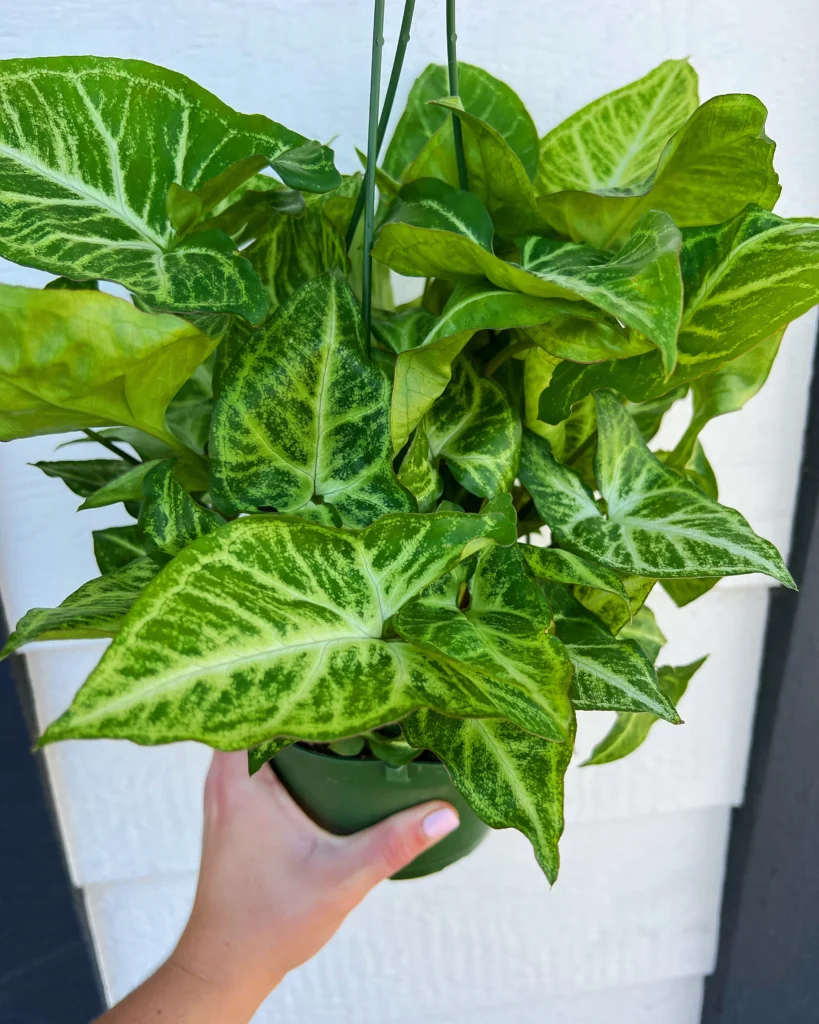
Which One Should You Choose?
Your choice between Syngonium White Butterfly and Neon Robusta depends on your plant care experience, your home’s lighting and humidity conditions, and the aesthetic you’re going for. Here’s how to decide:
- Best for Beginners: White Butterfly is more tolerant of light changes, underwatering, and average humidity. Ideal for those just starting a plant collection.
- Small Apartments / Limited Space: Neon Robusta’s compact and slower-growing nature makes it easier to manage on tabletops, bookshelves, or tight corners.
- Statement Foliage: Neon Robusta wins for bold, eye-catching color and uniqueness. Great for those wanting a visual focal point.
- Low Light Homes: White Butterfly handles lower light conditions (as low as 1,000 lux) without severe impact on its color or health.
- Pet-Friendly Homes: Unfortunately, neither of these plants is safe for pets. Both contain calcium oxalate crystals that cause irritation if ingested. Use shelves or hangers to keep out of reach.
Conclusion
Both Syngonium White Butterfly and Neon Robusta are stunning, beginner-accessible plants that add charm to indoor spaces. Their key differences in color, size, light sensitivity, and growth habit should guide your choice based on your personal environment and style preferences. For those seeking a resilient, fast-growing all-rounder, White Butterfly is hard to beat. For color lovers craving a splash of pink and a more compact footprint, Neon Robusta brings both beauty and class.
References
- Costa Farms. (2023). Syngonium Plant Care. Retrieved from https://www.costafarms.com
- National Gardening Association (NGA). (2024). Plant Database: Syngonium podophyllum. Retrieved from https://garden.org/plants
- University of Florida, IFAS Extension. (2021). Houseplants: Care and Selection. Retrieved from https://edis.ifas.ufl.edu/publication/MG243



